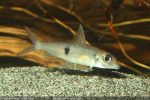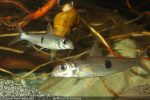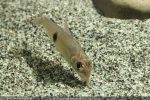taken from the Report 1/2019
In November 2017 Michael BÖTTNER organized a spectacular import from Suriname: Bivibranchia simulata. Nine specimens were imported by him and taken over by me (JK).
 They moved into a tank especially prepared for them (140x100x40 cm). The tank is filtered via a strong external filter, to which a few additional power pumps were installed to ensure sufficient water circulation. The pH is on a constant level of 7.5, the conductivity is 450 µS and the temperature is 29 °C. Considering their mouth, the tank was equipped with fine Granoflour sand from nature2aqua. It was structured with river stones and some bogwood. Finally, the fish were socialised with some plecos, with which no interspecific competition could be noticed.
They moved into a tank especially prepared for them (140x100x40 cm). The tank is filtered via a strong external filter, to which a few additional power pumps were installed to ensure sufficient water circulation. The pH is on a constant level of 7.5, the conductivity is 450 µS and the temperature is 29 °C. Considering their mouth, the tank was equipped with fine Granoflour sand from nature2aqua. It was structured with river stones and some bogwood. Finally, the fish were socialised with some plecos, with which no interspecific competition could be noticed.
 From the beginning, the tetras were active fish that – mostly in groups – used the entire swimming area, whereby it is clear that they live bottom-oriented and constantly search for food. I mainly feed them frozen food such as Artemia and mosquito larvae, but I also offer granulated food, which sinks quickly and is therefore ideal for the fish’s diet. With frozen food, they first try to eat the food near the surface, but this species is predestined to eat at the bottom, a behaviour which is like that of the better-known members of the genus Geophagus. The upper jaw is pointed diagonally downwards, and both the food and the substrate are picked up by the fish. My B. simulata spend most of the day in their group, or at least not far from it. Individuals regularly distance themselves from the loose group, which they immediately return to if disturbed. The fish are mainly diurnal. I cannot determine any sexual characteristics yet, but my specimens are not yet fully grown, and unfortunately B. simulata are not fast-growing tetras.
From the beginning, the tetras were active fish that – mostly in groups – used the entire swimming area, whereby it is clear that they live bottom-oriented and constantly search for food. I mainly feed them frozen food such as Artemia and mosquito larvae, but I also offer granulated food, which sinks quickly and is therefore ideal for the fish’s diet. With frozen food, they first try to eat the food near the surface, but this species is predestined to eat at the bottom, a behaviour which is like that of the better-known members of the genus Geophagus. The upper jaw is pointed diagonally downwards, and both the food and the substrate are picked up by the fish. My B. simulata spend most of the day in their group, or at least not far from it. Individuals regularly distance themselves from the loose group, which they immediately return to if disturbed. The fish are mainly diurnal. I cannot determine any sexual characteristics yet, but my specimens are not yet fully grown, and unfortunately B. simulata are not fast-growing tetras.
Of the 144 specimens analysed in the species description, the holotype with 138 mm standard length is the largest specimen. A good third of the deposited paratypes come from the Grand Roche rapids. These are mainly juvenile specimens (44-82 mm SL). It is conceivable that the juveniles are better protected from predators in the current-rich areas because sympatric predatory tetras such as Hoplias aimara and H. malabaricus avoid these when other areas are available to them for hunting. In addition, they certainly benefit from the constant supply of sediment and particles at these sites, which means nothing other than a constantly high supply of food.
 The genus name Bivibranchia already indicates a special feature of these fish. It is derived from the Greek and means two + ways + gills. The species name simulata points to the great similarity with B. bimaculata, with which B. simulata seems to be identical at first sight both in external morphology and in mouth and pharyngeal development. However, when comparing two specimens of the same size, B. simulata is higher backed, the head is slightly shorter, and the eyes are larger. At the level of the 20th-23rd and 26th-27th scute there is a round bisoval black spot, which is shorter in its expression than in B. bimaculata.
The genus name Bivibranchia already indicates a special feature of these fish. It is derived from the Greek and means two + ways + gills. The species name simulata points to the great similarity with B. bimaculata, with which B. simulata seems to be identical at first sight both in external morphology and in mouth and pharyngeal development. However, when comparing two specimens of the same size, B. simulata is higher backed, the head is slightly shorter, and the eyes are larger. At the level of the 20th-23rd and 26th-27th scute there is a round bisoval black spot, which is shorter in its expression than in B. bimaculata.
In Issue 01/2019, underwater pictures of the biotope of Bivibranchia simulata are added to the article.
Text: Josef KREITMAIR & Daniel KONN VETTERLEIN – Bilder: Daniel KONN VETTERLEIN